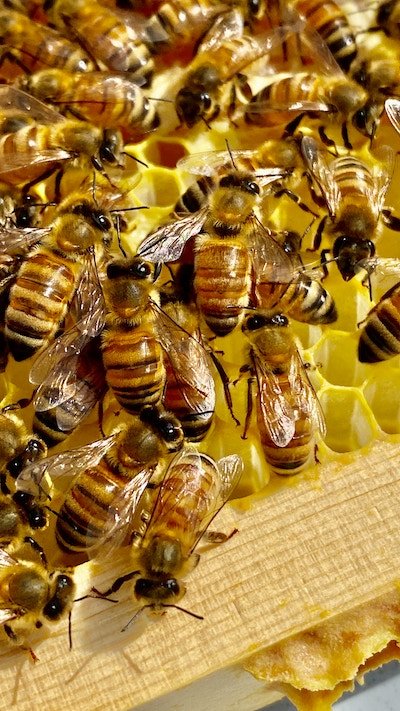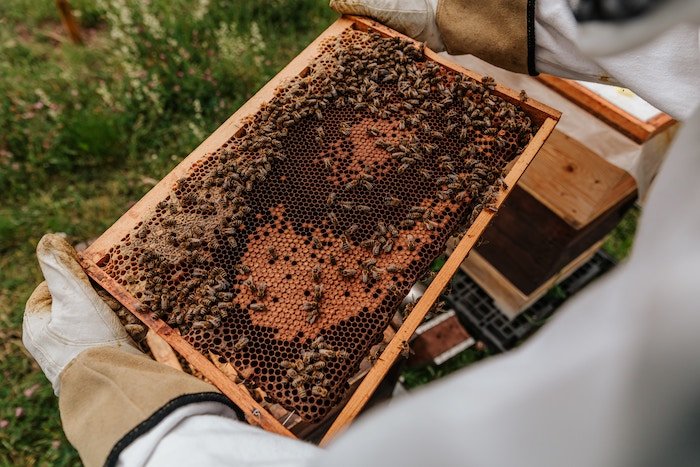
Pollinators: Meant to Bee
The author experienced firsthand God’s incredible design for bees—and mankind’s opportunity to steward even the smallest of God’s creatures.
The breeze rustled the pages of my book as I listened to dogs bark across the pond below my apartment balcony. Geese floated lazily through the muddy water, undisturbed by the noise.
As I glanced back down at the novel in my lap, something at my feet caught my eye—a bee, wedged between two boards on the deck. At work earlier that week, we’d discussed writing an article about bees, so I was instantly intrigued—but not enough to get any closer, afraid that the insect might buzz into action if I tried to touch it.
The next day, when I saw the bee still in the same place, I decided it was safe to approach. After carefully prying its lifeless body free, I sealed it in a Ziploc bag so I could show my team.
After an internet search, we determined that—based on its size and smooth, hairless abdomen—Barry (as we named it) was a carpenter bee. Intriguingly, Barry smelled like honey—though carpenter bees don’t make honey. We also noticed pollen dust still speckling its fuzzy body.
When God created bees with other flying creatures, likely on day five of creation week, they got right to work doing what they do best: collecting pollen and nectar while helping plants reproduce. Today, the world’s roughly 20,000 bee species fall into two categories: solitary and social. Solitary bees are the introverts of the bee world, living and working mostly alone. As a carpenter bee, Barry would have been flying solo.
Social bees, on the other hand, live and work for the success of their colony. Perhaps the most familiar of the social bees is the honeybee, well-loved for producing the honey we enjoy in tea or—in my case—drizzled on peanut butter toast.
Honeybees are responsible for pollinating one-third of every bite we eat, contributing nearly $15 billion to the nation’s economy.1 Thanks to beekeeping, farmers can manage where bees will pollinate specific crops. In fact, nearly two million honeybee colonies are shipped across the US to farms each year to aid in crop pollination, with some crops, like almonds, relying almost exclusively on honeybee pollination.2
No doubt, these incredible insects ensure our survival—and beekeepers are doing what they can to return the favor. Well-equipped by God, honeybees would probably manage just fine on their own, but beekeepers practice stewardship by giving bee colonies a safe place to flourish, while the insects provide their essential services to plants, animals, and humans.
Buzzworthy Business
In 2022, the US Department of Agriculture estimated that there were more than 200,000 beekeepers in the US, and hobbyists comprised 94% of that number.3 Among them is my father-in-law, Brian. Three years ago, Brian decided to start keeping bees to help pollinate his garden—though he admits, “The added benefit of honey is sweet too.” His enthusiasm whenever he talks about his bees makes me think that perhaps his favorite part is just watching the insects at work. “Seeing all the activity inside the hive is mind boggling,” he told me. “Those little guys are amazing. Absolutely amazing.”
Since discovering Barry several months earlier, I’d been planning a trip to Brian’s beehives in southeastern Tennessee. When my phone rang this past spring, I knew it was time to hit the road.
“How fast can you get here?” Brian asked as soon as I answered. He’d called to tell me that he was opening his hive the next day for the first time this year.
Four and a half hours later, I pulled into my in-laws’ driveway just as the sun was beginning to set. The day had been unusually warm for the beginning of March, and tomorrow’s forecast predicted the same, prompting Brian to crack open the hive for an inspection. As I stepped from my car, I glanced warily at Brian’s beehive standing at the edge of the driveway.
Meeting the Bees
The next afternoon, I met my father-in-law back in the driveway at his white pickup. I had pulled tall socks over my shins and layered on two pairs of pants, determined not to get stung.
Two nylon bee suits waited in the truck bed. As I pulled mine on, I noticed a small group of the insects gathered at the hive’s opening—called the reducer, I would later learn—probably returning from foraging trips to Brian’s sprouting vegetable garden or to the flowering dogwood trees at the wedding venue down the hill. As an estate coordinator for the wedding venue by day and a beekeeper, gardener, and backyard chicken owner by evening and weekend, Brian says that he is always learning something new about creation.
His chickens strutted around at our feet as he packed pine straw into the smoker, a small handheld device used to pipe smoke into hives, a strategy used to keep bees calm. It isn’t completely foolproof, though.
“If they do get really angry, run towards the road"
While lighting the pine straw with a match, Brian coached me on what to do if the smoke didn’t work. “If they do get really angry, run towards the road, and I’ll use the leaf blower to blow ’em away from you.” I swallowed my nerves, watching from several yards back as Brian smoked the hive. More bees flew out, but none of them seemed like a threat. I crept a little closer.
Brian removed the top of the hive and began unstacking the boxes, called superstructures, or supers for short. Inside each super were eight hanging frames on which the bees had built their comb for honey storage.
Today, Brian was removing the 20-pound (9 kg) block of sugar he’d left in the top of the hive at the start of winter to supplement his bees’ diet. He was adding a new super to make room for more brood (bee eggs, larvae, and pupae) and honey. He was also inspecting the health of the hive by examining the brood, checking the amount of honey production, and searching for the queen.
Inside the hive, hundreds of bees crawled around on the frames. Brian pointed out each type to me, recognizable by their size. Female workers, the smallest of the bees, comprised most of the colony. We spotted a few male drones, which were slightly bigger and rounder than the workers. And after slowly turning over each frame in search of the queen, we finally located her in the third super. She was the largest bee in the hive, longer than the workers and much slimmer than the drones. But besides her size, she was easy to spot because she had a bright yellow dot painted on her back. Each year, the beekeeping community chooses a color to mark queen bees so beekeepers can easily track their queen’s age, an especially helpful practice for keepers with more than one hive.
Despite her royal marking, Brian’s queen had a humble beginning. When he first installed this hive, he’d ordered a package of bees online that included a queen, several workers, and a feeder filled with sugar syrup. For the first week, the queen was kept in a cage apart from the rest of the colony. Since she was not their matriarch, the worker bees would have killed her or left the hive if she was introduced before they adjusted to her pheromones.
Different Beekeeping
Beekeepers disagree on the methods of keeping their colonies healthy. While some keepers treat their bees for pests and provide food for them in winter, other keepers just allow bees to, well, be bees, without any sort of intervention, except providing a hive. This means that the strongest hives survive any infestation or disease outbreak, and weaker ones die off. Both beekeeping methods have merit. The individual keeper must decide how to best care for his bees.
Comb Construction
As we examined each frame, I spotted the iconic six-sided cells. I later learned that honeybees expertly engineer the small spaces they nest in, utilizing each square millimeter by building the comb in a hexagonal pattern. The comb is made from wax that female worker bees secrete from glands on the underside of their abdomens. After the wax is secreted, the bees move the wax to their mouths and begin mixing it with saliva to create the right consistency for the comb-building material. Once the wax is pliable, worker bees begin constructing the comb.

Photo by Brad Weaver
Brian pointed out hundreds of capped brood cells on the comb. Inside each capped cell was a developing baby bee. He seemed especially interested in the several large, peanut-shaped cells we saw—queen cells, I learned.
“With this many queen cells, this hive will probably swarm,” Brian told me. Swarming happens when a bee colony outgrows its hive and splits into two. The old queen and many of the worker bees leave the old hive and swarm nearby. Beekeepers capture the swarm into a new hive. Meanwhile, in the old hive, a new queen is born and takes over.
Show Me the Honey
While Brian worked, I watched several of his bees return with bright yellow bulges on the sides of their legs. In preparation for my trip to Brian’s hive, I’d read that female worker bees are equipped with corbiculae—or pollen baskets—where they store pollen after collecting it from flowers. Pollen is packed with healthy fats and proteins that provide bee larvae the nutrients they need to grow and develop.

“When their baskets are all filled up like that,” Brian said with a grin, “I call them little linebackers.”
Bees also collect nectar with a proboscis (similar to a straw-like tongue). Nectar gives bees the energy they need for flight. They store excess nectar in their stomachs until they get to the hive. Once there, the nectar in the foraging bee’s stomach is passed from bee to bee, where enzymes in each bee’s stomach turn the sugar into diluted honey and remove excess water. The honey is put into a comb cell where another bee fans it with her wings to evaporate the rest of the water. When the honey has reached the right moisture level, the bees cap it with a wax lid, sealing the honey so it doesn’t lose moisture.
Healthy colonies of honeybees produce more honey than they need to survive, promising a sweet harvest for beekeepers each fall. Last year, Brian’s hives produced about 40 pounds of harvestable honey. Whenever I visit, he sends me home with a Ball jar full of the treat. During our inspection, he pointed out several frames already filled with capped honey. I was happy to see that my supply for next year seemed secure.
Keepers of the Hive
Bees and humans aren’t the only ones that crave what’s inside the hive. When animals began killing one another for food after the fall, honeybees had to defend themselves against pests, both big and small. Thankfully, God had equipped them to live in a fallen world with everything they need to fend off various intruders.
Near the end of our inspection, I noticed a tiny black beetle scurrying among some bees. When I pointed it out, Brian quickly pinched it between two fingers.
“Do you catch those a lot?” I asked.
“No, but I don’t want ’em in there,” he replied. “Guard bees will take care of ’em unless you get too many. Then you’ve got a problem.”
Beehives have their own security team that keeps the hive safe from pesky intruders like the hive beetle I spotted. The eldest bees in the colony are given the job of guards, as they have the most potent venom. A strong colony usually has 10–20 guard bees stationed near the entrance of the hive. If the threat is too big for the guards to handle, they call for backup by releasing alarm pheromones.
Brian explained that when a bee is away from its hive, it won’t attack unless threatened. But near the hive, a bee will do anything necessary to protect its home—even giving its life by stinging.
But honeybees have other less fatal strategies to defend the hive. Researchers have discovered that some honeybees collect animal poo that they use to paint the outside of their hives. The invading insects tend to spend less time at dirty hives than clean ones.
When the smelly varnish doesn’t work, a colony of bees might try bee balling. Hundreds of honeybees swarm around an intruder and vibrate their wing muscles to produce heat. The writhing ball of bees effectively cooks the invader.
Where Did All the Bees Go?
Brian and I finished our inspection without incident. I felt myself relax as he finished restacking the supers and put the top back on the hive. After stepping out of our bee suits, we walked over to the back porch. “You’ve seen what a healthy hive looks like,” Brian said, setting two more supers on the ground in front of me. “Now I want to show you a severely damaged one.”
If bees had classic western ghost towns, I imagined they would look like this. The frames were almost barren and were coated in a sticky white webbing. I wouldn’t have been surprised to see a bee-size tumbleweed roll through.
“That’s what wax moths’ll do,” Brian lamented. Just last year, these supers had been part of a healthy, thriving hive, producing much of Brian’s harvested honey. “It took four weeks for the moths to do this. When I harvested the honey, the hive looked great.” Despite his careful inspections and the bees’ defense strategies, the next time Brian checked on the hive, he found it completely destroyed.
A few wax moths can be warded off by diligent guard bees. But in a weak hive, wax moths are devastating. Once inside, female moths lay hundreds of eggs on combs or in cracks. After the larvae hatch, they tunnel into the honeycomb, leaving behind silky webbing and feeding on bee brood.
Honeybees face other pest threats, too. Hive beetles, like the one we found, lay their eggs in cracks, crevices, and other shadowed places in the hive—even punching through brood cell cappings to hide their offspring from patrolling bees. After the eggs hatch, beetle larvae feed on pollen, honey, and bee brood.
But perhaps the most notorious threat to honeybee populations is the Varroa mite. A tiny parasite that mainly attaches to and feeds on bee larvae and pupae, the mites often transmit viruses to bees, causing malformations and spreading disease in the developing brood. According to the US Department of Agriculture, the Varroa mite has destroyed mass numbers of US honeybee colonies since it was first discovered in 1987.4 Mites are especially deadly to commercial beekeepers with tens or hundreds of hives, as they can quickly infect each one.
From April 2020 to April 2021, beekeepers lost an estimated 45.5% of their colonies.
Overall, this startling bee decline is complex. From April 2020 to April 2021, beekeepers lost an estimated 45.5% of their colonies.5 The losses can’t be blamed solely on pests like mites and moths, though. Additional factors, like pesticide exposure and nutrition deficits due to drought and inclement weather, have led to what’s known as colony collapse disorder, where most of the adult bees in a colony abandon the hive, leaving behind the larvae, a queen, food, and some nurse bees. Since each member of the colony plays a vital role in the upkeep of the hive, it’s not long until the remaining bees, including the larvae, are dead.
To combat these challenges, entomologists are breeding bees to be resistant to Varroa mites. This year, the USDA approved the first-ever honeybee vaccine to prevent another bee disease known as foulbrood. God has given mankind the responsibility to steward his creation, and entomologists and beekeepers are doing just that by exploring ways to manage the bee decline. “I can’t save every creature in the world,” Brian told me, “but I can help in my backyard with the bees.”
Despite the threats to their survival in our fallen world, bees and other pollinators who got their start in Eden will continue pollinating until the end of the earth. They are, after all, part of God’s promise that seedtime and harvest will continue as long as earth remains (Genesis 8:22). And beekeepers like Brian get the pleasure of helping to manage the bees’ efforts—and seeing the wonder of the Creator’s design up close.
At Home with the Bees
The sun was low in the sky as Brian and I walked back inside late that afternoon. Other than a few straggler bees returning home for the night, the hive was quiet. But from what I now knew, I was certain that inside the hive, the colony was still swarming with activity.
Back in the office a few days later, I was still thinking about my visit with the bees. I pulled Barry the bee out to marvel at its design again. Its fuzzy body, sweet honey smell, big black eyes, and iridescent wings all held new meaning for me. Maybe I was meant to find Barry on my balcony those months ago.
“You could definitely talk me into suiting up again,” I texted Brian after gently putting Barry back in its bag.
I guess, in some small way, I’m a beekeeper too.
Not All Bees

The conversation around bee decline mainly focuses on the honeybee. Though beekeepers report significant losses to their colonies each year, some entomologists believe there are likely more honeybees on the planet today than ever before, thanks in part to beekeepers’ stewardship.
Amid our important efforts to save the bees, we often overlook the 4,000 US native bee species—including bumblebees and carpenter bees. Many of these species face a population crisis. In fact, in the past two decades, American bumblebee populations fell as much as 90%.
Native bees face the same main threats to their survival as honeybees: pesticide exposure, disease, and habitat loss. But native pollinators must also compete with honeybees for pollen and nectar resources. Honeybees, imported from Europe in the 1600s, are expert foragers, and because of the commercial bee industry, which ships them across the nation to mass pollinate crops, honeybees are everywhere. According to one study, a single honeybee colony can collect 22 pounds (10 kg) of pollen during the summer months—enough to feed the offspring of 100,000 native bees.
Like honeybees, native bees play a vital role in pollinating earth’s wide variety of plants. If we’re going to care for bees, we need to care for all bees, stewarding our yards with native bees in mind (learn how on page 71).
Answers Magazine
July–September 2023
The undercurrent of Critical Race Theory is tugging students away from God’s Word. How should parents respond?
Browse Issue SubscribeFootnotes
- M. Shahbandeh, “Number of honey bee colonies in the United States from 2016 to 2022 (in million)*,” Statista, May 25, 2023, https://www.statista.com/statistics/755263/bee-colonies-us/.
- Elizabeth Allon, “Honey Bees Vs. Highways,” Beepods, January 19, 2022, https://www.beepods.com/honey-bees-vs-highways/#:~:text=The%20truth%20is%2C%20nearly%202,to%20increase%20pollination%20at%20farms.
- Melanie Howard, “Beekeeping As A Hobby (Is Right It For You?),” Beekeeping for Newbies, May 8, 2020, https://www.beekeepingfornewbies.com/beekeeping-hobby/#:~:text=The%20U.S.%20Department%20of%20Agriculture,94%25%20of%20them%20are%20hobbyists.
- “ARS Honey Bee Health,” Agricultural Research Service US Department of Agriculture, https://www.ars.usda.gov/oc/br/ccd/index/#:~:text=Parasites%20and%20pests%3A%20Varroa%20mites,the%20United%20States%20in%201987.
- “United States Honey Bee Colony Losses 2020–2021: Preliminary Results,” Bee Informed, June 21, 2021, https://beeinformed.org/2021/06/21/united-states-honey-bee-colony-losses-2020-2021-preliminary-results/.
Recommended Resources

Answers in Genesis is an apologetics ministry, dedicated to helping Christians defend their faith and proclaim the good news of Jesus Christ.
- Customer Service 800.778.3390
- © 2024 Answers in Genesis






